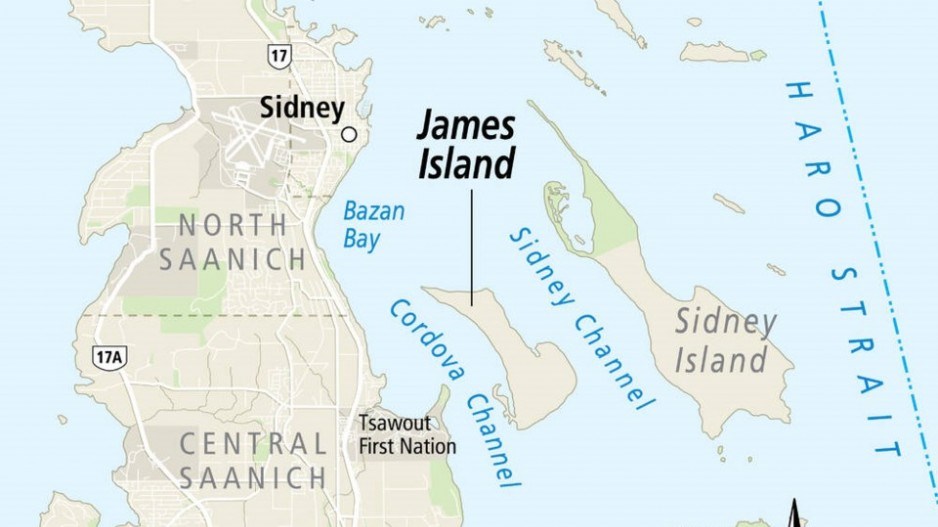The provincial government has denied an American development company’s application to subdivide James Island.
The application from J.I. Properties, a company owned by Seattle telecommunications billionaire Craig McCaw, was for the development of upscale vacation homes on the island, east of the Saanich Peninsula.
The application was denied by the province, in part, due to the “outstanding negative impacts” the development would have on Tsawout First Nation, whose long history on the island includes village sites, food harvesting and numerous burial grounds. The island is known as ȽEL¸TOS in the SENĆOŦEN language.
“Through consultation with Tsawout, the province has begun to recognize our deep and undeniable connection to ȽEL¸TOS,” said Tsawout elder Mavis Underwood in a statement. “We are pleased that this development proposal will not proceed. ȽEL¸TOS is an integral part of our culture and community, and it is past time that it be returned to our stewardship.”
The decision from Ryan Evanoff, the provincial approving officer for the Ministry of Transportation and Infrastructure, cited considerations around access, potable water, sewage, public interest and land use, including archeological, geotechnical and environmental impacts. Alongside risks of environmental damage from septic contamination and saltwater intrusion, Evanoff said approval of the subdivision application would negatively impact “Tsawout’s Aboriginal interests.”
“I consider this type of development to be more of a detriment to the conservation, stewardship, and environmental protection of the Island, as the owners are likely to have less of a connection to the local area and less of an interest in caring for the island,” Evanoff wrote, referring to Tsawout First Nation’s connection. “Tsawout has been clear from the outset of the consultation process that the scope and style of the proposed subdivision is incompatible with its social, cultural, and environmental values.”
Evanoff also made reference to discussions with the North Pender Island Local Trust Area, which includes local governments from more than 39 associated islands within the Islands Trust, including James Island, Sidney Island and D’Arcy Island. In 2008, the group approved rezoning of the island, but it has since “adopted significant resolutions” around reconciliation with Indigenous communities.
Tsawout First Nation councillor Abraham Pelkey’s great- great-grandmother was born and raised on the island, Pelkey said. It’s a place he and many other Tsawout people hold close to their hearts. “It’s a big moment and I believe it’s going to be one of many because it sets us on the path to reconcile our differences between the past wrongdoings of the province and the [federal government],” Pelkey said. “That nation-to-nation relationship is coming forth and starting to be adhered to.”
John Gailus, legal counsel for Tsawout First Nation, said the decision is noteworthy for its application of provincial commitments under the United Nations Declaration of the Rights of Indigenous People (UNDRIP), passed by the United Nations in 2007.
In March, the provincial government released a Declaration Act Action Plan, outlining 89 actions for government ministries. “I think this is the first time, that I’m aware of, that there’s a concrete application of the DRIPA [Declaration on the Rights of Indigenous People Act] acts in a provincial approval process,” Gailus said. “I think that’s significant.”
The rural subdivision application from J.I. Properties, submitted in 2009, was given a letter of preliminary layout approval, but the application was then inactive until April 2014, when J.I. Properties requested to extend the initial approval, but had to resubmit application materials. Over the following years, conditions were added, including consultations with First Nations.
A revised layout plan for 76 residential and three commercial lots was issued in July 2020. Consultations with Tsawout First Nation took place between late 2019 and March 2022.
Tsawout First Nation has an ongoing civil claim for the return of the island to its people. The First Nation, whose community looks across Cordova Channel to the 770-acre island, claims it never gave up ownership and was wrongfully forced off the land by the government in 1870, when the province sold James Island in five parcels for $1 an acre, with no compensation to the Tsawout people.
In 1889, 400 acres of the island were listed for sale, and the island has since passed from one private buyer to another, with the most recent owner, J.I. Properties, purchasing it in 1994 for $26 million. The island currently hosts a 5,000-square-foot residence, six guest cottages, private docks, an airstrip, pool house and 18-hole golf course. In 2021 the property, including the buildings, was assessed at $54.7 million by the B.C. Assessment Authority.




